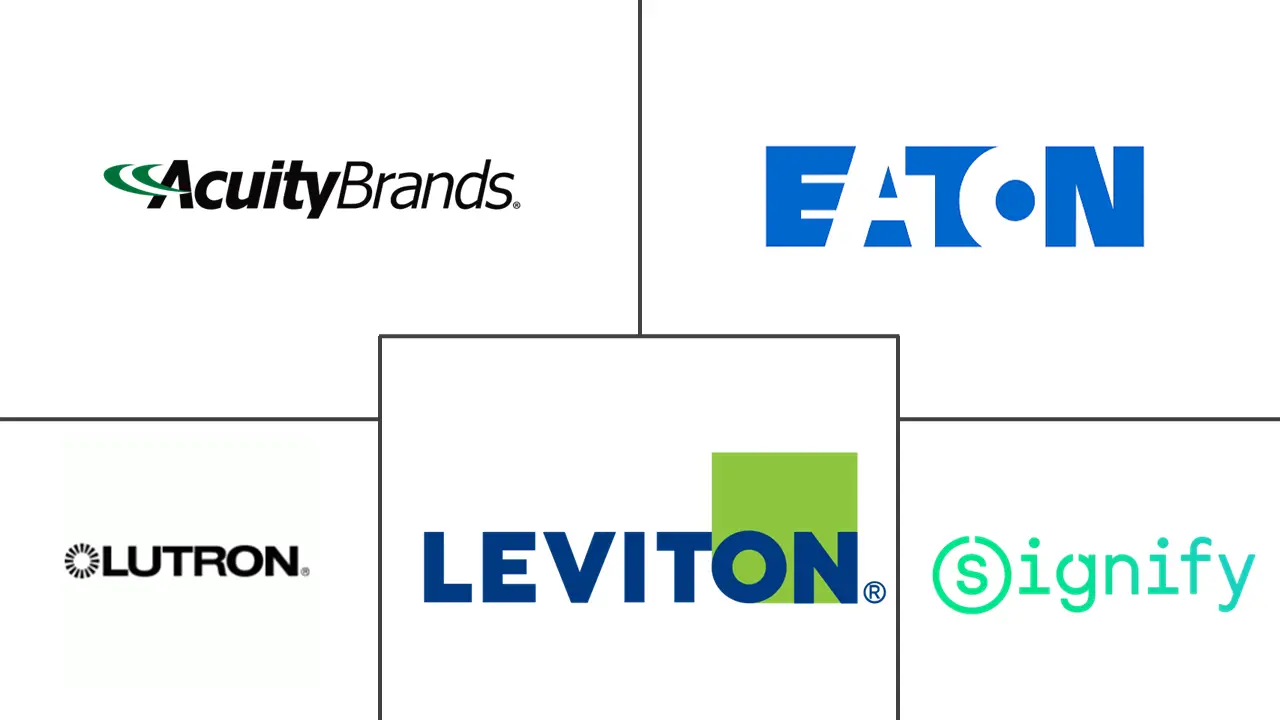North America Commercial Lighting Control Market Size and Share
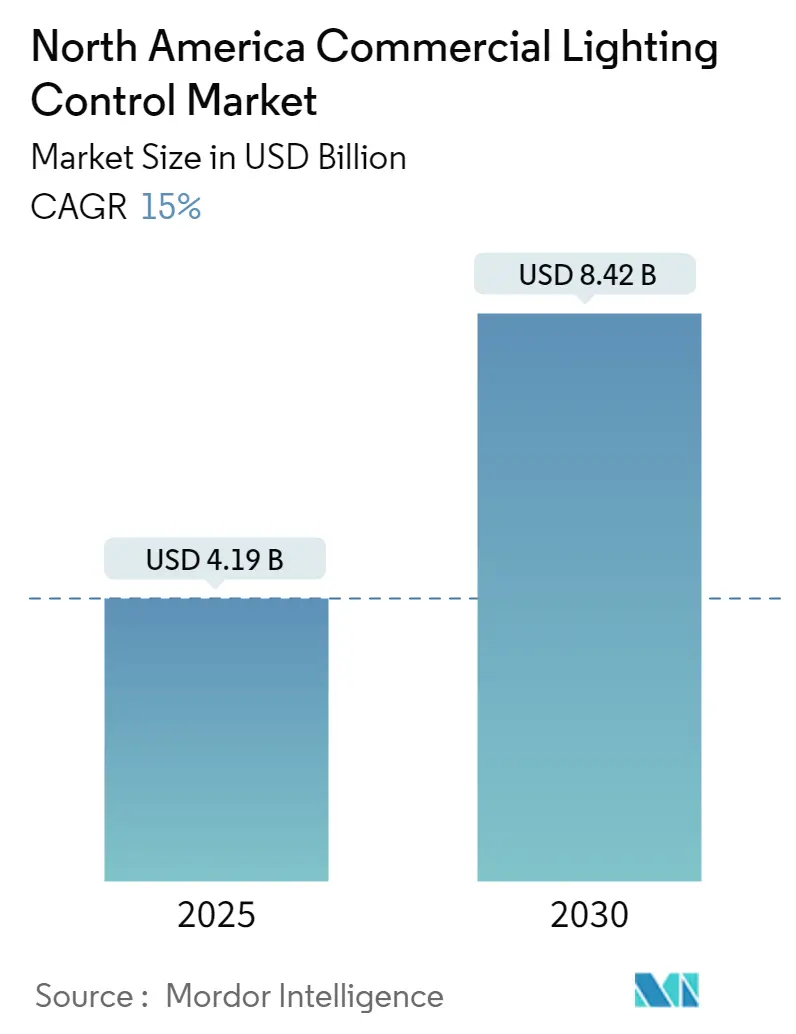
North America Commercial Lighting Control Market Analysis by Mordor Intelligence
The North America Commercial Lighting Control Market size is estimated at USD 4.19 billion in 2025, and is expected to reach USD 8.42 billion by 2030, at a CAGR of 15% during the forecast period (2025-2030).
• The United States and Canada are the most prominent countries in North America that favor energy-saving lighting controls over conventional systems. These systems' significant producers and suppliers are located in North America, where their products are used for commercial or industrial indoor lighting applications. This area's growth is driven by demand from different sectors, prominent competitors, and product manufacturers of lighting control systems.
• Moreover, the Department of Energy (DOE) and the Federal Energy Regulatory Council (FERC) oversee energy regulation in the United States. These agencies lay down the national policy the commercial lighting sector must follow. For instance, open-plan office spaces, cafeteria dining facilities, and quick restaurants are often equipped with occupant sensor controls. Under Title 24 regulations, rules must be set to control general lighting within the 'zones' where the floor area is at most 600 square meters. After 20 minutes for occupants to leave a particular zone, all lights shall be switched off in any monitored area.
• The wired communication system offers many advantages, such as enhanced security, reduced maintenance costs, and improved energy efficiency, and is used in all types of commercial settings in the region. The growing demand for automatic lighting systems is one of the significant factors that has fueled growth in wired communication. As a result of their lower cost and higher energy efficiency, the use of automated lighting solutions is increasing.
• There is an inverse relationship between temperature and the performance of light-emitting diodes and the products utilizing them. As LED lights are powered by electricity and produce heat, the output will differ according to junction temperature. Such a barrier has prevented the widespread adoption of intelligent lighting control systems. However, factors such as the declining price of LEDs and significant energy savings achieved by carrying out energy-efficient lighting control systems are expected to reduce the effect of this limitation in the short term.
• The factors at the macroeconomic level, such as supply chain disruptions due to events like natural disasters and geopolitical tensions, can affect the availability of components, raw materials, and finished products. This can result in delays in the production and delivery of various products, including LED drivers, sensors, switches, dimmers, relay units, and gateways, ultimately slowing market growth. Additionally, more infrastructure development in both rural and urban areas may ensure the adoption of lighting control systems, thereby restricting opportunities for market growth.
North America Commercial Lighting Control Market Trends and Insights
Wireless Communication Protocol Segment is Expected to Grow Significantly
- Wireless Lighting Control devices are gaining popularity for commercial applications in the region. These devices use wireless lighting technology to control and monitor lighting infrastructure, which in many ways is more advantageous than traditional wired systems.
- Wireless lighting control is a device or system that uses radio frequency signals to communicate with other Smart Light elements in a network environment. This allows users to monitor different lighting systems on their mobile devices, which means there is no need for the physical interconnection of wires between one set of lights. This implies the need for hardwiring control devices is eliminated, guaranteeing simple installation and maintenance. In addition, without requiring any modification to the architecture or construction of new electrical pathways, light control platforms may be easily installed in current infrastructures. This is the primary reason for the growing popularity of wireless lighting control systems for regional commercial setups.
- Energy efficiency is an additional benefit of wireless, intelligent lighting controls. In the case of unoccupied rooms, wireless devices can be configured to shut down the lights, thereby reducing energy consumption automatically. To allow for better monitoring and reporting of energy consumption, it can also be complemented by Building Management Systems to identify areas in which energy savings could be achieved. In addition, eligibility for energy codes, rebates, and tax breaks may be facilitated by this. Also, according to the GSMA Intelligence, North America is expected to have approximately 1.4 billion new intelligent commercial buildings with Internet of Things connections during (2018-2025), which will concurrently drive wireless communication technology.
- A wide range of devices, including motion and light sensors, dimmers, wireless switches, LED drivers and lamps, bridges, luminaire controllers, and gateways that allow connections to existing building management systems, can be connected through a well-functioning lighting control network. These components shall be combined to provide the necessary means of efficient, remotely controlled operation of daylight harvesting strategies, occupancy indicators, and energy savings scenarios in a given space.
- Bluetooth mesh networking, which could transform the promise of intelligent services based on data in a building into a reality, has emerged as an efficient and reliable solution for commercial lighting control. The mesh of Bluetooth can be used to create a vast network of devices. It is most suitable for management, automation systems, and monitoring where thousands of devices need to communicate with one another in such a way as to ensure the highest degree of performance, reliability, and security. One of the use cases that have been rapidly adopted by Bluetooth mesh is advanced commercial lighting control systems.
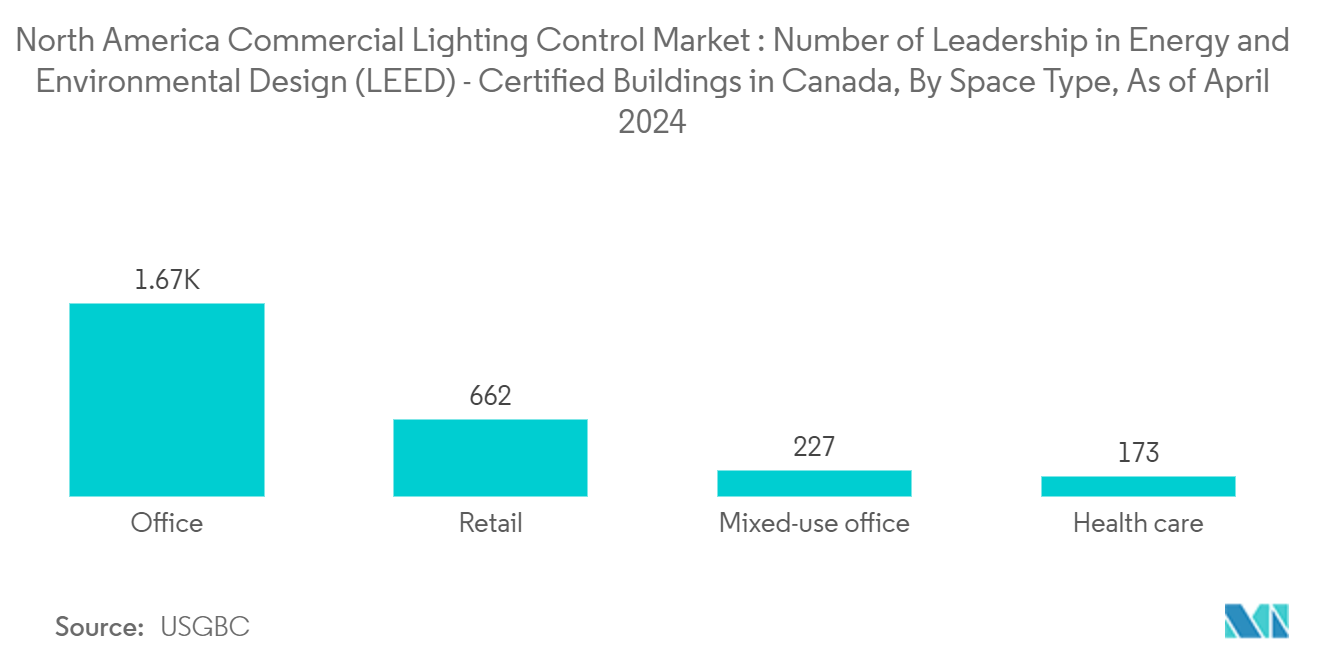
United States is Expected to Witness Significant Growth
- There are multiple benefits of commercial lighting controls. The United States Department of Energy estimates that about 40% of energy consumption is generated by lighting installations in commercial buildings. According to the Energy Department, almost 30% is spent on illuminating areas which are not used at all. As a result, it is the country's fifth most significant energy use. Such cases force the government to take the necessary initiatives to control energy usage. This might play an essential role in the market growth.
- Lighting controls such as LED lighting are now widely used in various applications, ranging from small keychains to flood lighting in football stadiums. The United States Department of Energy anticipates that the energy efficiency of light sources will continue to advance through 2050, leading to a decrease in environmental impact and operational expenses.
- Retail outlets, office buildings, and public sector buildings, such as government-owned properties, are increasingly adopting LED technology on a large scale to slice down on energy consumption and improve energy efficiency. According to the DOE (Department of Energy), LED is considered a very efficient lighting technology and can significantly alter the future of lighting in the United States. The widespread adoption of LED lighting could lead to substantial energy savings in the United States. It is projected that by 2035, most lighting systems will utilize LED technology, thus driving the market's growth.
- Moreover, the major players in the country are focusing on collaborations and partnerships with other leaders to develop advanced hardware that caters to the market. For instance, in October 2023, Signify's portfolio was strengthened by adding ULT (Universal Lighting Technologies) product designs, patents, and trade names. For many years, Signify's Advance brand has been a competitor of ULT in product categories such as LED drivers, LED modules, and fluorescent ballasts. Acquiring patents and product designs in these areas is a strategic decision that could provide lasting advantages for Signify and Advance.
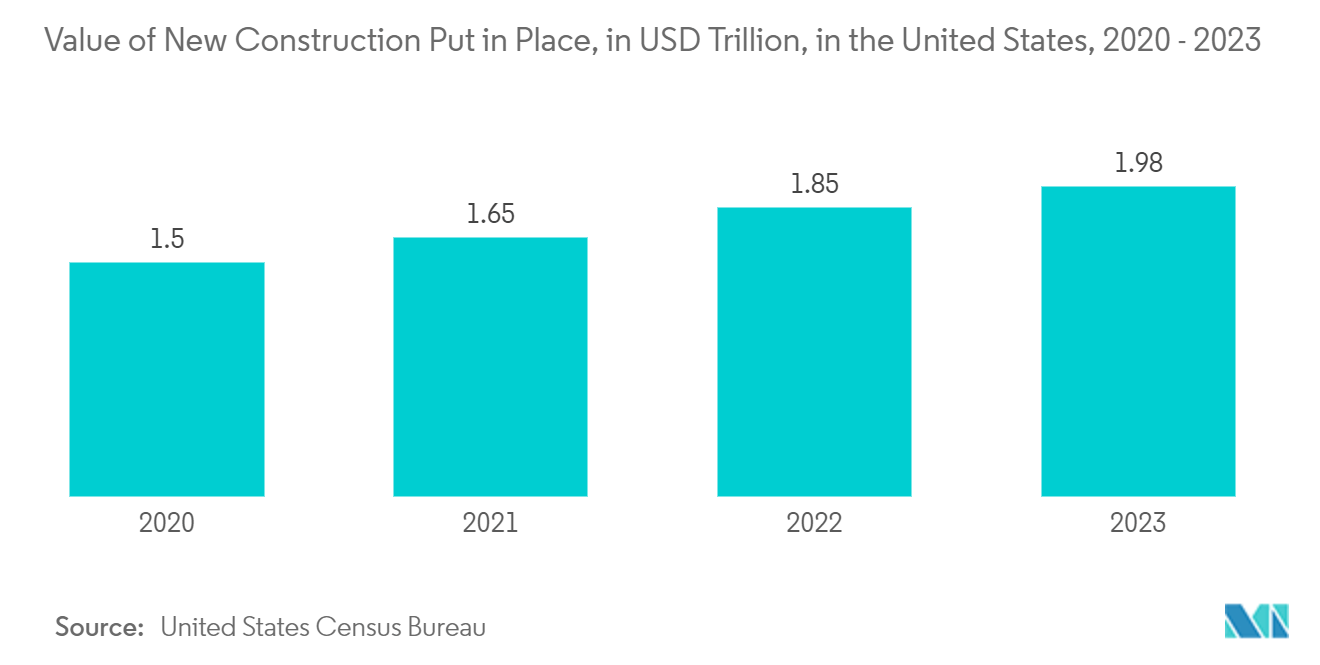
Competitive Landscape
The North American commercial lighting control market is very competitive. The North American market is highly concentrated due to various large and small players. All the major players account for a significant market share and focus on expanding the global consumer base. Some significant players in the market are Acuity Brands Inc., Eaton Corporation, Lutron Electronics Co. Inc., Leviton Manufacturing Co. Inc., Signify Holding, and many more. Several companies are increasing their market share by forming collaborations, partnerships, and acquisitions and introducing new and innovative products to earn a competitive edge during the forecast period.
• March 2024: The new collaboration between Acuity Brands and Hort Americas signals a significant development in horticulture lighting, emphasizing technological innovation and increasing energy efficiency. Acuity Brands' purchase of the Arize range of horticulture lighting products earlier this year resulted in a broader reach in controlled environment agriculture. The partnership between the two companies is focused on introducing advanced lighting solutions and innovative technology to the industry, taking advantage of Acuity Brands' status as the biggest lighting manufacturer in North America.
• March 2024: MaxLite introduced the release of c-Max Network Partners, which offers a sophisticated network lighting controls option that integrates MaxLite's extensive c-Max controls-ready light fixtures. MaxLite selected Silvair as a network partner because of its comprehensive technology stack for advanced wireless controls and IoT enablement using Bluetooth Networked Lighting Control (NLC) open standards. This partnership goes beyond combining two technologies; it aims to establish a higher benchmark for innovation and user-friendliness in the lighting field.
North America Commercial Lighting Control Industry Leaders
Acuity Brands, Inc.
Eaton Corporation
Lutron Electronics Co., Inc.
Leviton Manufacturing Co., Inc.
Signify Holding
- *Disclaimer: Major Players sorted in no particular order
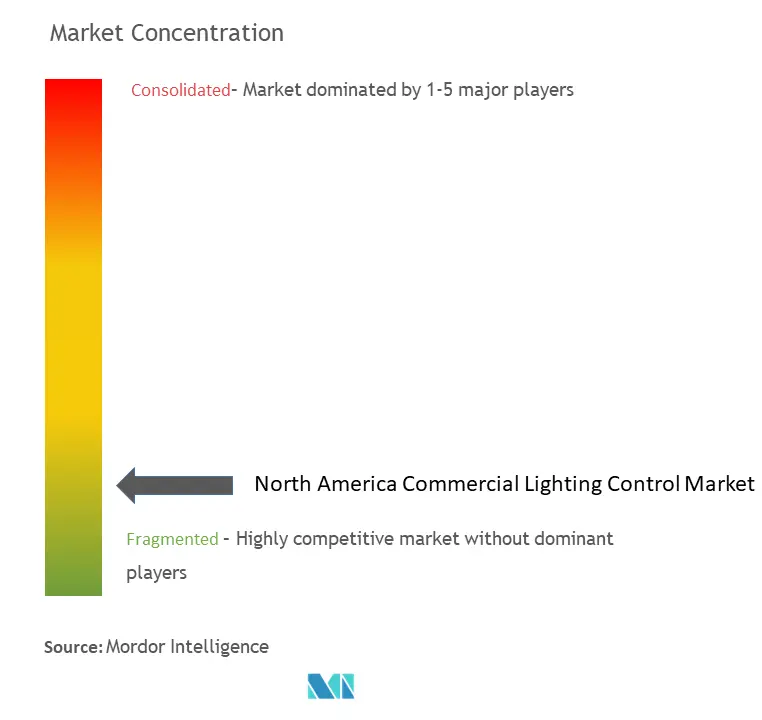
Recent Industry Developments
• March 2024: Acuity Brands, the largest company in North America specializing in commercial lighting and controls, seeks to introduce new and advanced products and services to the commercial horticulture industry. The company's lighting, sensors, components, and controls are widely utilized in various lighting sectors across North America, such as commercial indoor, outdoor, industrial, infrastructure, and healthcare applications. Acuity Brands comprises over 25 different brands specializing in lighting and controls.
• March 2024: Signify significantly changed its representation of lighting control brands in the New York Metro and Northern New Jersey areas, with Synergy Electrical Sales taking over as the new representative. Starting April 1, Synergy Electrical Sales would expand its partnership with Signify to include the Genlyte Solutions portfolio, consisting of brands like Lightolier, Day-Brite, and Stonco. Synergy Electrical Sales aims to enhance support for regional commercial projects with Signify's advanced LED and connected lighting solutions.
North America Commercial Lighting Control Market Report Scope
For market estimation, we have tracked the revenue generated from the sale of types of hardware and software offered by different market players for a diverse range of applications. The market trends are evaluated by analyzing the investments made in product innovation, diversification, and expansion. Further, the advancements in wired and wireless communication protocols are also crucial in determining the growth of the studied market.
The North American commercial lighting control market is segmented by type (hardware [LED driver, sensors and switches and dimmers, relay units, gateways], software), by communication protocol (wired, wireless), and by country (United States, Canada). The report offers market forecasts and size in value (USD) for all the above segments.
| Hardware | LED Drivers |
| Sensors | |
| Switches and Dimmers | |
| Relay Units | |
| Gateways | |
| Software |
| Wired |
| Wireless |
| United States |
| Canada |
| By Type | Hardware | LED Drivers |
| Sensors | ||
| Switches and Dimmers | ||
| Relay Units | ||
| Gateways | ||
| Software | ||
| By Communication Protocol | Wired | |
| Wireless | ||
| By Country | United States | |
| Canada |
Key Questions Answered in the Report
How big is the North America Commercial Lighting Control Market?
The North America Commercial Lighting Control Market size is expected to reach USD 4.19 billion in 2025 and grow at a CAGR of 15% to reach USD 8.42 billion by 2030.
What is the current North America Commercial Lighting Control Market size?
In 2025, the North America Commercial Lighting Control Market size is expected to reach USD 4.19 billion.
Who are the key players in North America Commercial Lighting Control Market?
Acuity Brands, Inc., Eaton Corporation, Lutron Electronics Co., Inc., Leviton Manufacturing Co., Inc. and Signify Holding are the major companies operating in the North America Commercial Lighting Control Market.
What years does this North America Commercial Lighting Control Market cover, and what was the market size in 2024?
In 2024, the North America Commercial Lighting Control Market size was estimated at USD 3.56 billion. The report covers the North America Commercial Lighting Control Market historical market size for years: 2019, 2020, 2021, 2022, 2023 and 2024. The report also forecasts the North America Commercial Lighting Control Market size for years: 2025, 2026, 2027, 2028, 2029 and 2030.
Page last updated on:
North America Commercial Lighting Control Market Report
Statistics for the 2025 North America Commercial Lighting Control market share, size and revenue growth rate, created by Mordor Intelligence™ Industry Reports. North America Commercial Lighting Control analysis includes a market forecast outlook for 2025 to 2030 and historical overview. Get a sample of this industry analysis as a free report PDF download.
